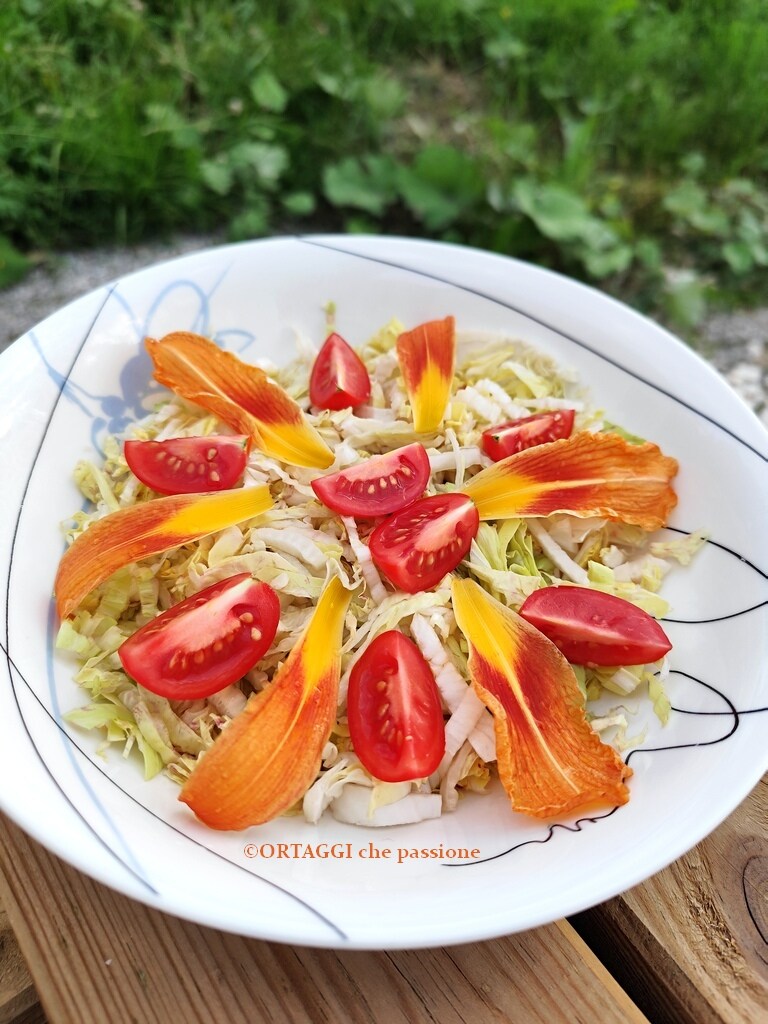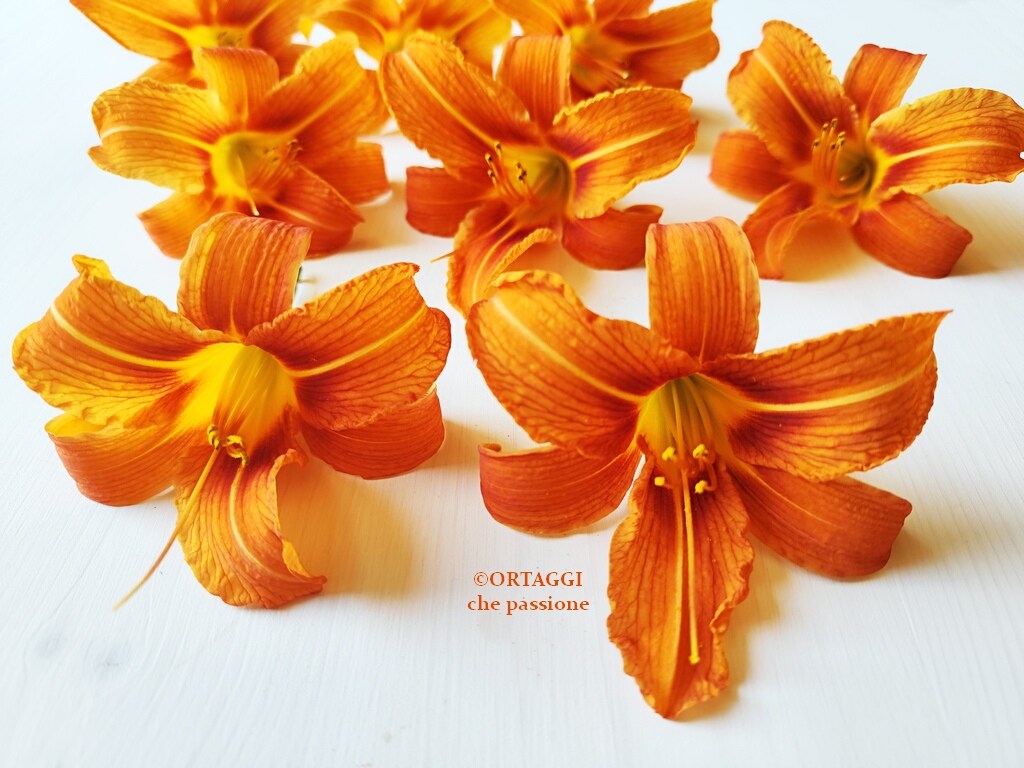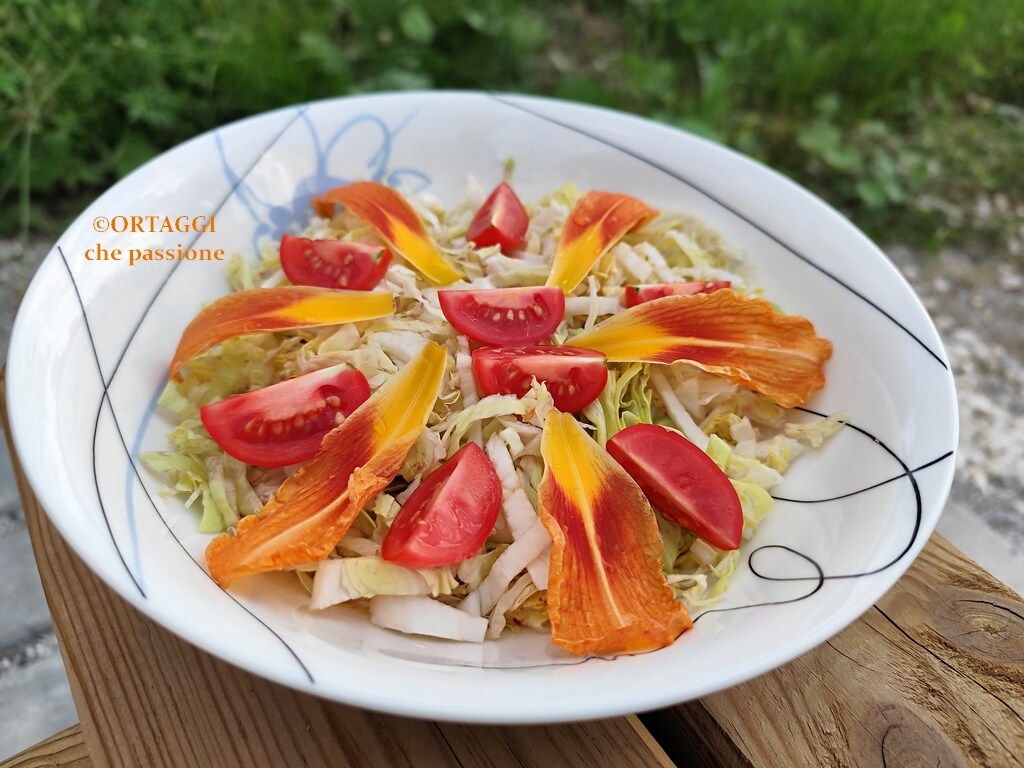The salad with St. Joseph’s lilies is a simple, fresh, and colorful recipe, perfect for bringing the petals of this elegant flower, abundant in gardens, to the table. The Hemerocallis, or Daylily, is a perennial plant that is not only ornamental but also edible. Young buds can be sautéed or added to soups and oriental dishes, while open flowers are great raw, stuffed, or fried.
Also known as St. Joseph’s lily or Turkish lily, the Hemerocallis has Asian origins, and its name means “beauty of a day,” because each flower lasts only 24 hours. Despite this, the plant blooms generously for weeks, providing a continuous show.
Its cultivation is easy: robust and undemanding, it adapts easily and resists drought well, becoming an ideal presence in sustainable gardens thanks to its warm and vibrant flowers.
SEASON of St. Joseph’s lilies: the flowers bloom from May to July depending on the altitude of the collection area. The corollas open in the morning, when the flower is at its peak, offer the most perfect petals.
Each flower lasts just one day, but the plant produces numerous buds along the stem, ensuring a spectacular bloom for weeks.
COLD salad recipes

- Difficulty: Easy
- Cost: Economical
- Preparation time: 10 Minutes
- Portions: 2People
- Cooking methods: No cooking
- Cuisine: Healthy
- Seasonality: Spring, Summer
- Energy 30.96 (Kcal)
- Carbohydrates 4.75 (g) of which sugars 0.95 (g)
- Proteins 1.37 (g)
- Fat 1.18 (g) of which saturated 0.18 (g)of which unsaturated 0.12 (g)
- Fibers 2.99 (g)
- Sodium 26.11 (mg)
Indicative values for a portion of 100 g processed in an automated way starting from the nutritional information available on the CREA* and FoodData Central** databases. It is not food and / or nutritional advice.
* CREATES Food and Nutrition Research Center: https://www.crea.gov.it/alimenti-e-nutrizione https://www.alimentinutrizione.it ** U.S. Department of Agriculture, Agricultural Research Service. FoodData Central, 2019. https://fdc.nal.usda.gov
Salad with St. Joseph’s Lilies
- 4 St. Joseph's lilies (typically there are 6 petals per flower)
- 4 cherry tomatoes (or grape tomatoes)
- 6.35 oz romaine lettuce (or other type – cut into strips or pieces)
- to taste lemon juice (or other citrus juice)
- to taste extra virgin olive oil
Tools
- Cutting board
- Knife
Salad with St. Joseph’s Lilies
They should be harvested in the morning when they are fresh and open. Only the petals are used, not the stem or pistil.

Wash the lettuce and cherry tomatoes. Gently wash the Turkish lily petals with cold water to remove any insects or residues.
Cut the lettuce into strips and some of the petals (alternatively, break them into regular pieces with your hands).
Cut the cherry tomatoes into wedges.
Assemble the salad by decorating it with some whole Hemerocallis petals.
Season with citrus juice (lemon and/or orange) and for an extra touch, enrich with chopped nuts or seeds like chia, sunflower, poppy, sesame, or pumpkin.
🍀🍀🍀🍀

🍀🍀🍀🍀
Ingredients (for 2 people)
– 1-2 cucumbers (if organic, use the skin too)
– a handful of fresh raspberries (or other types of berries)
– 10-12 petals of St. Joseph’s lilies (always Hemerocallis, just to be sure!)
– a few fresh mint leaves
– 1 tsp of apple cider vinegar
– extra virgin olive oil to taste
– a pinch of salt
– 1 tsp of honey or agave syrup (optional)
How to prepare
Cut the cucumber into very thin slices, preferably with a mandoline or vegetable peeler, to obtain a sort of carpaccio. Arrange it on a wide plate. Add the raspberries scattered here and there, whole or slightly squished if you want to release some of their juice.
Gently distribute the cleaned lily petals and a few mint leaves. Prepare a light emulsion with oil, vinegar, salt, and, if you like, a drop of honey. Pour the dressing over the salad just before serving.Ingredients (for 2 people)
– 4-5 baby potatoes
– 1 handful of fresh green beans
– 10-12 petals of St. Joseph’s lilies
– 1 tsp of mild mustard (or Dijon)
– 1 tbsp of lemon juice or white wine vinegar
– extra virgin olive oil to taste
– fresh herbs to taste (basil, thyme, parsley, or chives)
– salt and freshly ground black pepper
How to prepare
Wash the baby potatoes thoroughly and cook them by steaming or in salted boiling water until tender but still firm. Meanwhile, trim the green beans and cook them.
Cut the potatoes in half or into thick slices, add the green beans, and dress with an emulsion of oil, lemon juice, and mustard, adjusting the salt. Add the chopped fresh herbs and mix everything while the vegetables are still warm so they absorb the flavors well.
Only at the end, add the petals of St. Joseph’s lilies, gently distributing them over the salad as a final touch.Ingredients (for 2 people):
– 4.2 oz of basmati rice or fragrant long-grain rice (like jasmine)
– 2 ripe but firm apricots
– 10-12 petals of St. Joseph’s lilies
– a few fresh basil leaves (or mint, lemon balm)
– grated zest of organic lemon
– delicate extra virgin olive oil (optional)
– salt to taste
How to prepare
Cook the rice in slightly salted water, drain well, and let it cool on a large tray to dry and separate the grains. Meanwhile, wash the apricots and cut them into thin wedges. Carefully wash the lily petals.
Once the rice is cold or just warm, add the apricots, finely chopped herbs, lemon zest, and a drizzle of oil, salt.
Finally, complete with the lily petals, which will be like strokes of color and fragrance.Ingredients (for 2 people)
– 2 handfuls of mixed greens or valerian lettuce
– 1 ripe but firm pear (such as Williams or Abate)
– 10-12 fresh petals of Hemerocallis fulva
– 1 handful of shelled walnuts
– 1 tsp of pumpkin or sunflower seeds (optional)
– a few drops of lemon juice
– extra virgin olive oil to taste
– salt (optional)
How to prepare
Wash the mixed greens well and dry them gently. Slice the pear thinly, without peeling it, and drizzle with a few drops of lemon juice to prevent browning. In a large bowl, combine the salad, pear slices, broken walnuts, and optionally, the seeds.
At this point, add the lily petals, well washed, distributing them as small decorative touches here and there. Dress with a drizzle of extra virgin olive oil and a pinch of salt.
Tips
You can enrich the salad with some cubes of fresh vegetable cheese or with almond slivers. Or dress it with a vinaigrette of lemon (or orange) juice and mustard.
STORING the salad with St. Joseph’s Lilies
To keep the salad with St. Joseph’s Lilies fresh longer, it is important to store it only if it is not yet dressed. This way, the petals remain crisp and fragrant. Simply place it in an airtight container or wrap it gently in plastic wrap and store it in the refrigerator.
Dress it just before serving.
FAQ (Questions and Answers)
What is the taste of the petals?
The petals have a mild and slightly sweet flavor, vaguely reminiscent of raw zucchini or romaine lettuce with a floral note and an herbal aftertaste. They are not overpowering, so they pair well with light salads.
Are all types of lilies safe to eat?
No. Only certain varieties, such as the Hemerocallis, are edible. Other lilies, like the classic Lilium, are toxic to humans and pets, especially cats. It is essential to accurately identify the plant before consumption.
Is the salad with St. Joseph’s lily petals really edible?
Yes, but be careful: the St. Joseph’s lilies most commonly used for food are not the ornamental white lilies (like Lilium candidum), but the Hemerocallis fulva, also known as “daylily.” The fresh (not wilted) flowers of Hemerocallis are edible.
Are there health benefits?
Edible flowers are rich in antioxidants, vitamin C, and natural pigments. Hemerocallis petals contain phenolic compounds and carotenoids, which may help fight oxidative stress.
Can I eat them raw, or do I need to cook them?
For the salad, they are used raw, but some oriental recipes also include cooking the buds (e.g., in soups or stir-fried). The raw petals are more delicate and colorful, ideal for decorative use.
Is it safe to serve them to children or during pregnancy?
Generally yes, but with moderation. As with all spontaneous or unusual plants in the diet, it is better to introduce them gradually and only after ensuring individual tolerance. During pregnancy, it is better to avoid excessive consumption of uncommon wild plants.
Can they cause allergies?
In particularly sensitive individuals or those allergic to pollen or certain plants, mild reactions may occur. Those with food allergies should test with a small amount or avoid them.

